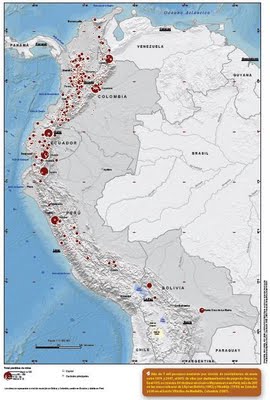25 October 2009
New atlas of natural disaster threats in the Andes
Posted by Dave Petley
On Friday the Andean Community of Nations (CAN) (Bolivia, Colombia, Ecuador and Peru) released an atlas of potential natural disasters affecting the countries of that region, which has come out of the PREDECAN project. It presents maps of the distributions of earthquakes, volcanic eruptions, landslides, flooding, frost and drought, with a special emphasis on El Nino / La Nina.
As far as I can tell this atlas is available only in Spanish (not unreasonably of course), but it is available online in its entirety, which is certainly one better than the World Bank hotspots project. Of course I am most interested in the landslides section – and this deserves more than a single post – but for now let me just give an overview of the landslides chapter.
The headline figures in the analysis are that between 1970 and 2007 about 11,000 people were killed and 38,000 homes were destroyed by landslides. About 260 landslides killed more than 20 people and/or destroyed more than 50 houses. El Nino is a key control on the occurrence of slides. The following map presents the distribution of fatal landslides, with the size of the spot representing the number of fatalities in each case. The darker grey area is the zone covered by this study:
The study also presents the results of an analysis of trends of occurrence of larger (20+deaths and/or 50+ homes destroyed) landslide accidents:
Clearly the data suggest that more landslides have occurred since the mid 1980’s than before, but this may well be an artifact of the data. Note that since the mid 1990’s there is no clear overall trend, although the period in the late 1990s characterised by the large El Nino event is clearly evident in the data. A moderate El Nino event is thought to be developing at present.




 Dave Petley is the Vice-Chancellor of the University of Hull in the United Kingdom. His blog provides commentary and analysis of landslide events occurring worldwide, including the landslides themselves, latest research, and conferences and meetings.
Dave Petley is the Vice-Chancellor of the University of Hull in the United Kingdom. His blog provides commentary and analysis of landslide events occurring worldwide, including the landslides themselves, latest research, and conferences and meetings.